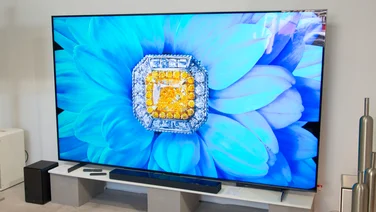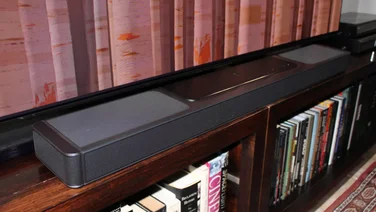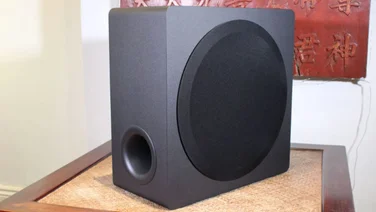To help us provide you with free impartial advice, we may earn a commission if you buy through links on our site. Learn more

If you’ve been hankering for a Blu-ray player and surround-sound system, but don’t really have the room or money to buy separates, the Panasonic SC-BT230 could well be what you’re after. It’s an all-in-one Blu-ray player and 5.1 surround-sound system, complete with tiny satellite speakers.
The satellite speakers are impressively small, and should be easy to discretely tuck out of site and view. That will only leave you to find space for the slightly-larger passive subwoofer. Sadly, placement of speakers could be a bit of an issue, as Panasonic has fitted the speaker cables with a proprietary connector at the Blu-ray player end.
These are colour coded to make plugging in the speakers easier, but make it incredibly hard to replace the cables. While the front speakers and subwoofer all have a healthy amount of cable, the rears have around 7m. This should be fine for most people, but it’s easy to eat up cable by routing it around bookshelves and the like. Fortunately, the speakers all have spring terminals, so you could join normal speaker cable to the proprietary ones if you need more length.
While a lot of all-in-one systems like this lack features compared to home theatre separates, Panasonic has managed to squeeze a load into this package. For starters, the impressively thin, considering it’s also an amplifier, and the Blu-ray player has an HDMI 1.4 output. While there’s no support for 3D Blu-ray discs, it can also be used with an audio-return channel (ARC) on a compatible TV, so you can pump the sound from your flat panel into the SC-BT230 and use its surround sound.
Beyond that there’s an iPod dock hidden underneath a flap in the top of the player. It supports all modern iPods and lets you play music through your speakers. Beyond that, there’s an SDXC memory card slot, so that you can view AVCHD video and JPEG photos directly from your digital camera or camcorder.
If you’d rather view files stored on your network, there’s a full DLNA client that will connect to UPnP servers when you connect the player to your network via the integrated Ethernet port (an optional 802.11n USB wireless adaptor can be added). It supports most common file formats, including MP3 for audio, and DivX HD, MPEG-2 and AVCHD for video. The interface is a little basic, but it’s easy enough to find your way around.
Panasonic has also integrated its Viera Cast, which lets you stream content from the internet. It’s rather lacking at the moment with YouTube and Picasa Web Albums the main features, but no on-demand TV, such as iPlayer.
While all of these things are nice extras to have, what will make or break the SC-BT230 is its performance in movies. Things certainly look promising flicking down the spec sheet, when you see that both Dobly Digital True HD and DTS-HD MA lossless formats are supported. These sound much cleaner and more vibrant when compared to DVD’s lossy audio codecs.
While both of these standards support up to 7.1 channels of sound, the SC-BT230’s 5.1 speaker configuration isn’t a problem: most living rooms don’t have enough space for the extra speakers and you need to be in a large room for 7.1 systems to sound any different.
We fired up some test DVDs to see how they sounded. In fairness to the system, the micro satellites do a fairly good job. In Harry Potter and the Goblet of Fire we managed to hear all of the subtle noises of the tiles being ripped from Hogwarts in the Dragon scene. Switching to the Helicopter chase in Shara, the bullets ricocheting could be heard clearly.
However, we felt that the speakers lacked punch and vibrancy and made movies feel a little flat. The bigger issue here is that the passive subwoofer just can’t deliver those heart-stopping thumps we’d expect in a film. Overall, Panasonic has made sure that the sub is balanced against the speakers, so that bass doesn’t overwhelm everything, but it us wishing for a little more rumble and punch to low noises, such as explosions.
There’s not much you can do to try and balance the sound the way you want it, as there are only four preset sound equaliser settings to choose from (Flat, Heavy, Clear and Soft). The only configuration options for the speakers are to control the rear and centre speakers’ delay and volume, in order to get the best surround effect.
There in is another minor problem: we weren’t overly impressed by the sound envelope. Objects moving from left to right (front or rear) were handled well, but objects moving from front to back, or vice versa, didn’t do so that smoothly. In effect, it was more like there were two sound fields – one in front and one behind – rather than a smooth envelope.
It’s by far a poor surround sound set, but it just doesn’t produce the thrills and excitement we like to hear in movie sound tracks.
There’s nothing wrong with the image quality at all. Blu-rays can be played at Full HD 1080p resolutions at 24fps, while DVDs are neatly upscaled. The player supports the 4:4:4 Y’CbCr chroma subsampling, which is used in high-end film scanners and cinematic post production. It should help produce more accurate colours, although the overall effect will depend heavily on your TV’s capabilities.
Still, if you’re thinking about upgrading your telly soon, it’s good to know that this player will be able to produce the highest quality picture when you need it.
That said, it’s difficult to whole heartedly recommend this product. It’s pretty good value considering all of the features and it is incredibly easy to set up. However, we just didn’t feel that excited by the sound it produced, leaving us feeling a little flat. Buying a separate amp and speakers with an active subwoofer will get you way better results, but you’ll have to be willing to pay more.






